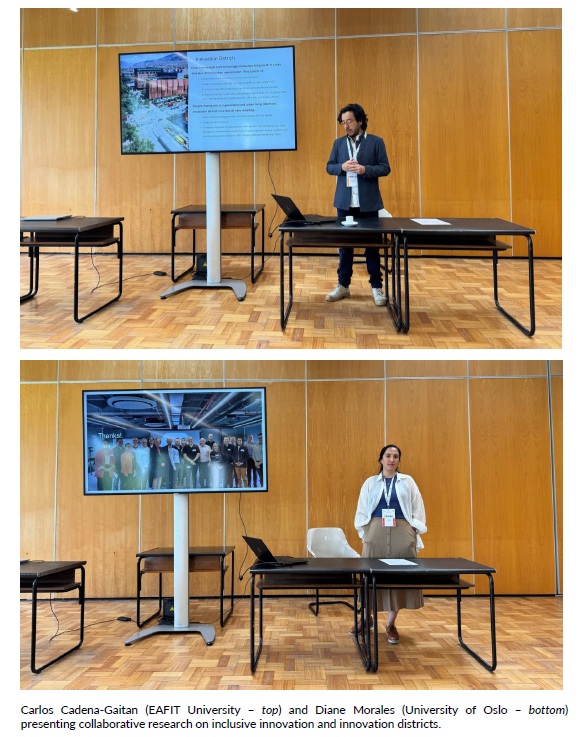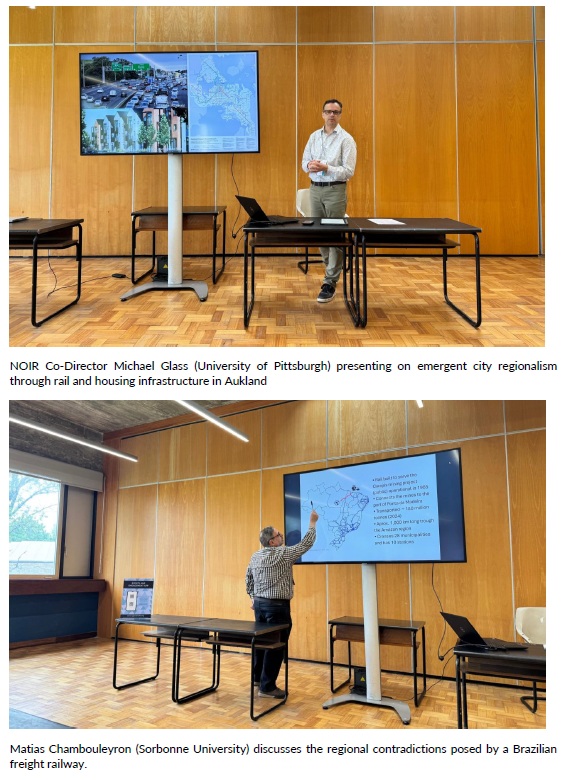RSA Events – Event Report – Inclusive Infrastructures and the Dynamics of Regional Transformation by RSA Research Network on Infrastructural Regionalism (NOIR)

RSA Events – Event Report – Inclusive Infrastructures and the Dynamics of Regional Transformation by RSA Research Network on Infrastructural Regionalism (NOIR)
The 2025 RSA Annual Meeting in Porto (on inclusive innovation) by Regional Studies Association Research Network on Infrastructural Regionalism (NOIR)
By Dr. Jean-Paul Addie (email), Urban Studies Institute, Georgia State University (USA), Dr. Michael Glass (email), Urban Studies Program, University of Pittsburgh (USA) and Dr. Jen Nelles (email), Oxford Brookes University Business School (UK)
About NOIR
The RSA Research Network on Infrastructural Regionalisms (NOIR) challenges regional studies to address infrastructural questions by critically unpacking how infrastructure shapes regional lives, governance, and developmental pathways. Our conceptual framing of ‘infrastructural regionalism’ focuses on those infrastructures that have relevance beyond the local. Analysing regions through infrastructure provides a novel perspective on the regional question, as investment and disinvestment in infrastructure reveal vital discursive and material elements that produce, structure, and modify metropolitan regions worldwide. The development of infrastructural assets – ranging from transport and telecommunications to energy and sanitation – as part of regional policies raises conceptual and applied questions about how the funding, governance, and spatiality of such infrastructure can promote urban, economic, and ecological sustainability at the regional scale.
NOIR’s Aims:
- Showcase theoretically informed, empirically grounded research at the intersection of infrastructure studies and regional studies.
- Promote the formation of collaborative, interdisciplinary, and comparative research teams to stake out and mobilize new research agendas at the intersection of infrastructure and the region.
- Foster novel scholarship through senior/junior scholar and academic/practitioner exchanges at RSA network events.
- Promote information exchanges that can inform regional development policies.
Report
Inclusive Infrastructures and the Dynamics of Regional Transformation
This session evaluated the relationships between inclusive regional transformation and infrastructure investment. A recent OECD report on ‘inclusive infrastructure’ argues that infrastructure is fundamental for fostering regional economic development and wellbeing, and that contemporary policy should look to closing ‘infrastructure investment gaps’ that exacerbate regional inequality (OECD 2024). Thinking regionally about infrastructure provides a framework to understand how infrastructural development and regional space are interlinked, and how they combine to shape new regional futures. We invited papers that evaluate the relationships between infrastructural investment, inclusiveness, and regional growth, covering themes including:
- The role of multi-scalar governance in supporting infrastructure projects that enhance long-term development plans with community aspirations. What are the planning tools and frameworks that ensure beneficial community consequences of investment?
- The capacity of public-private partnerships to coordinate for beneficial outcomes across the regional scale. How are projects delivered that comply with the needs of local communities
- Conceptual approaches to understanding the intersections between infrastructural investment and inclusive growth. Can infrastructure be inclusive?
- Case studies and comparative analysis
The NOIR special session was attended by 15 people, with presenters and co-authors coming from China, Colombia, France, Norway, the United Kingdom, and the United States.
SS23: Inclusive Infrastructures and the Dynamics of Regional Transformation
• Carlos Cadena-Gaitan, EAFIT University and Diane Morales, University of Oslo (presenting for co-authors David Marlow, Louise Kempton, and Michael Glass): “Inclusive Innovation: Definitions, Challenges and Innovation Districts”
• Michael Glass, University of Pittsburgh (presenting for co-author David Waite): “Evaluating Emergent City-Regionalism through Infrastructure: A Case for Livability, Growth, or Both?”
• Matias Chambouleyron, Laboratoire Médiations – Sorbonne Université, “1,000 km of opportunity or obstacle? The regional contradictions of the Carajás railway”
The papers were selected from a pool of submissions to an open call, given their focus on and engagement with questions of regional infrastructure and infrastructural regionalism. We paid particular attention to issues of disciplinary and topic diversity and sought to include presentations from early career researchers.
The session featured presentations on inclusive innovation and innovation districts, emergent city regionalism through rail and housing infrastructure in Auckland, and the regional contradictions a Brazilian freight railway poses. These rich presentations shared essential insights that will continue to shape discussions about the equity impacts of infrastructure and how infrastructure might mitigate these.
When we started this network, we decided not to restrict our focus to a single region definition. This is partly because, during our research, we have all adopted slightly different regional lenses, but also because we wanted to allow ourselves and our membership to explore the topic without restrictions. Whatever the definition employed, however, we encouraged participants in the network and our events to consider how these definitions shape infrastructure and how infrastructure itself can shape perceptions (and institutionalization) of regionalisms. The presentations in this session engaged with three very different regional imaginaries. Glass’s presentation focused most specifically on an institutionalized region – the Super City city-region of Aukland – arguing that even though one of the ambitions of the Super City was to increase the efficiency of regional transportation planning there are some doubts as to whether regional priorities are being appropriately integrated into what appear to be city-centric expansion plans. The region Chambouleyron presented was not an administrative construction, but a regional territory set on the spine of the Carajás railway in Brazil between the mines in Parauapebas and the port of São Luís. This presentation questioned the degree to which this region adequately benefits from the rail line beyond mineral exports, concluding that, in its present form, it creates more obstacle than opportunity. Cadena-Gaitan et al’s contribution was a comparative interrogation of the hyper-local innovation infrastructure of innovation districts in four urban contexts. Here the regional was implicit, as innovation districts are often woven into narratives about expanding regional innovation capabilities. Their research interrogated the localized impacts of innovation infrastructure often designed to serve regional interests and minimizing scrutiny of their impact on local communities.
In their critical approach to innovation infrastructure, Cadena-Gaitan et al. highlighted that inclusiveness was often part of the design of innovation districts. However, they demonstrated very different track records in aligning the benefits with the needs of the adjacent, often historically marginalized communities. In considering this, I wondered whether part of the challenge might involve how inclusiveness is framed and implemented as part of these projects. A recent analysis of innovation and economic policies in the UK showed that sustainable innovation is often framed in terms of economic benefit. The result is that while these policies use the “right” language, there is little prioritization of sustainability beyond advancing (or mitigating impact on) economic goals. As a result, where there is an attempt to maintain accountability, success is declared if the stated economic results were obtained (or in progress). At the same time, much less attention is paid to other equity or inclusion consequences of investment. It would be interesting to interrogate the inclusion narratives in these projects to explore the degree to which they are equally ambitious and meaningful in their efforts and execution beyond economic results. This is also worth exploring in the Auckland city-region, where the City Rail Link (CRL) project provides a technical fix to land use pressures and the affordability crisis, but appears disconnected from the housing solutions tackling the same issues. Here there may be different perspectives of which inclusion challenges are the highest priorities and which “fixes” will be most effective that are tied to how the region is perceived and who gets do the seeing.

The Auckland case is interesting as an example of an attempt to align governance with the geographies of infrastructure to plan better and manage the system. Improving transportation planning effectiveness was one of three explicit goals of metropolitan reform. Including the previously fragmented communities along the rail line was crucial to enabling that ambition. Fifteen years on, however, territorial divisions persist within the amalgamated structures. While it does not invalidate the idea that efficiencies can be extracted from aligning institutional boundaries with regional infrastructures, this case does demonstrate that institutional fixes may not be a magic bullet to overcome challenges associated with regional fragmentation. Indeed, forcing communities together in top-down arrangements may exacerbate parochialism by denying actors within the structure the independence to make deals. This raises questions for infrastructural regionalism and governance scholars about which institutional structures and strategies are most effective in overcoming fragmentation. Further challenges become evident when effectiveness is viewed not only in operational terms but through a lens of (regional) inclusion. Through this we return to a perennial question for our network of which actors get to “see” like a region, and which version of the region should be prioritized in infrastructure agendas.
There is little doubt that infrastructure can play an essential role in both creating and mitigating inequalities. The presentations highlighted equity challenges in local communities around innovation districts, regional land use and housing affordability, and cities and territories underserved by a private rail line. What is most interesting was that solutions (and workarounds) always seemed to be emerging around not one, but several, infrastructural fixes. In Brazil, roads and truck transport serve communities not being served by rail lines, with attendant infrastructure and consequences for sustainability. In Auckland, housing and rail are not effectively aligned, but they provide competing approaches to the problem of affordable housing (and moving) for a metropolitan population. Innovation districts demonstrate that innovation infrastructure cannot effectively promote inclusiveness (or innovation) without incorporating displacement mitigation strategies, energy use considerations, or appropriate links to digital and physical networks. As such, there is perhaps an interesting thread to pursue about the intersections and alignments of infrastructural fixes and how different perceptions of regionalism and governance coalitions clash or become complementary at that interface.

Event recaps for the 2024 RSA Winter, 2025 AAG, and 2025 RSA conference events have been posted on the NOIR website and shared via the Networks social media accounts. We are currently strategizing publications options based on NOIR 2.0’s first three events and are keen to leverage the insights of these initial conversations into collective outputs. Towards this end, we are now developing plans for a Network collaborative writing workshop to align with the 2026 RSA Annual Conference. In addition, future thematic panels are under consideration for the 2025 RSA Winter Conference and 2026 RSA Annual Conference, which are centered on issues including innovation infrastructures, governance arrangements, and regional blue infrastructure.
Jean-Paul Addie, Michael Glass and Jen Nelles